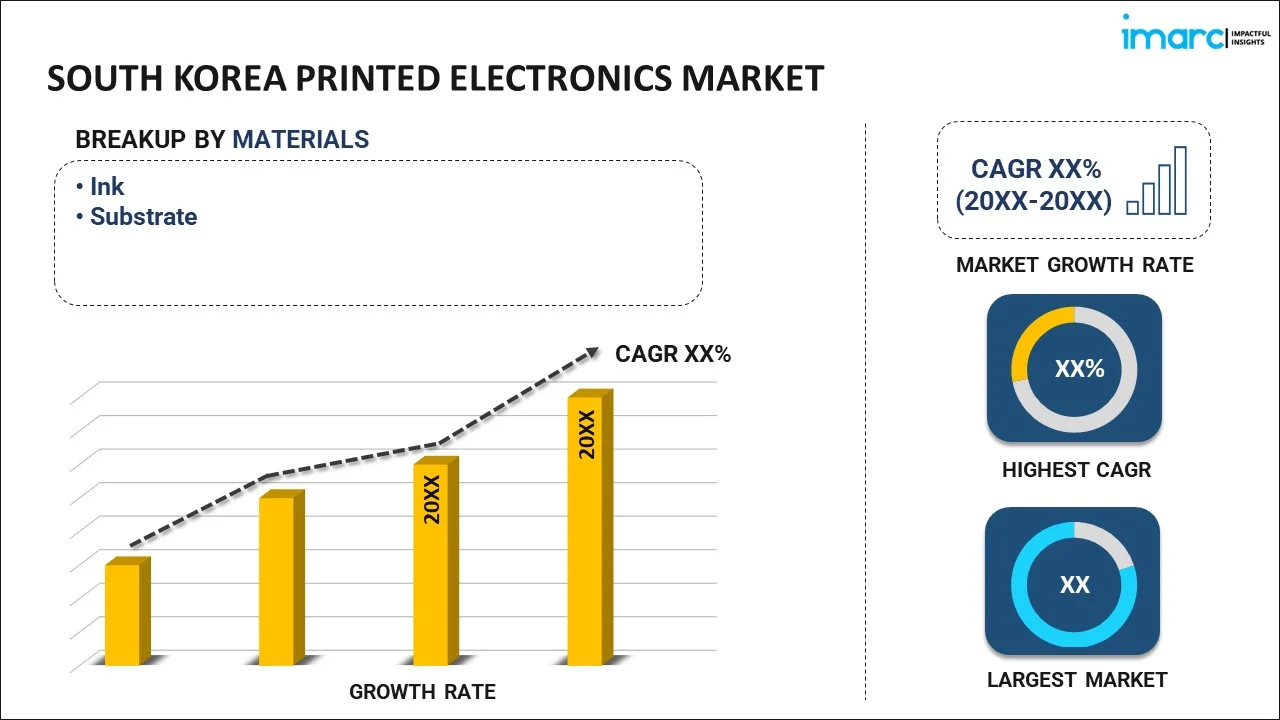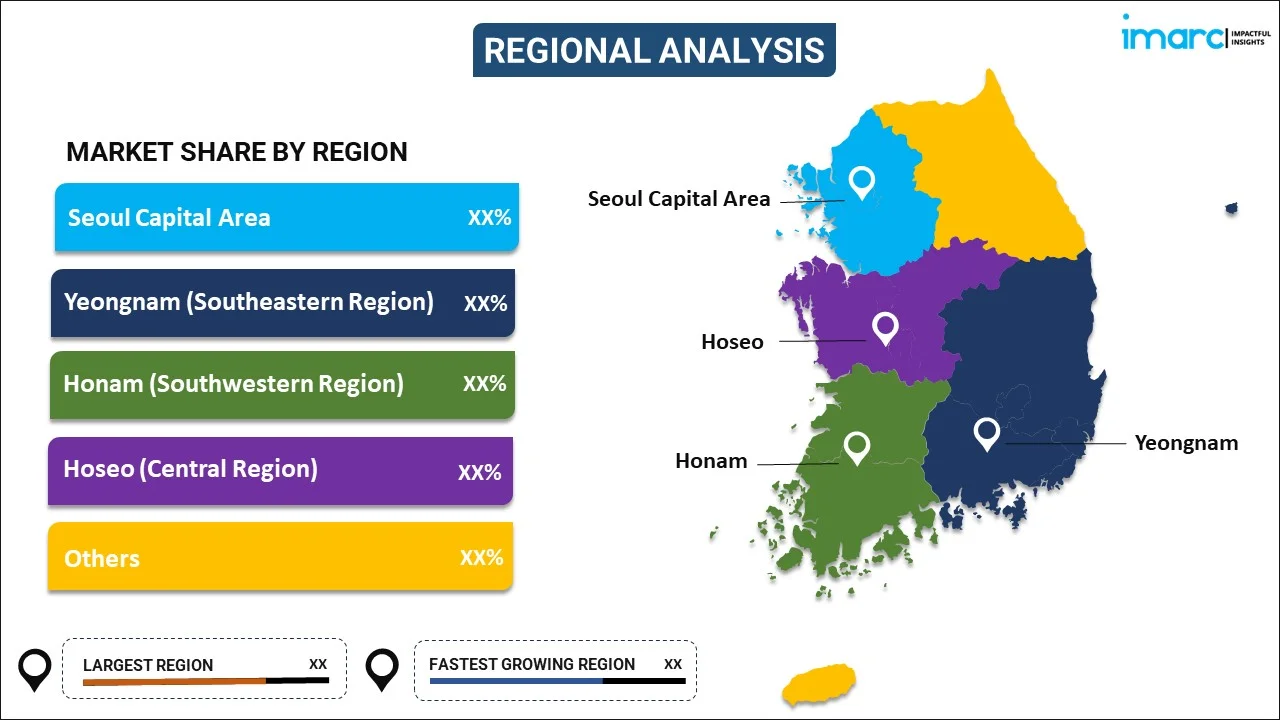
South Korea Printed Electronics Market Report by Material (Ink, Substrate), Technology (Inkjet, Screen, Gravure, Flexographic), Device (Display, Photovoltaic, Lighting, RFID, and Others), and Region 2024-2032
Market Overview:
South Korea printed electronics market size is projected to exhibit a growth rate (CAGR) of 18.50% during 2024-2032. The escalating demand for lighter, thinner, and more energy-efficient electronic devices, continuous advancements in materials, printing techniques, and fabrication processes, and the growing concerns about environmental sustainability represent some of the key factors driving the market.
|
Report Attribute
|
Key Statistics
|
|---|---|
|
Base Year
|
2023 |
|
Forecast Years
|
2024-2032
|
|
Historical Years
|
2018-2023
|
| Market Growth Rate (2024-2032) | 18.50% |
Printed electronics is a technology that utilizes printing processes to create functional electronic devices, such as transistors, sensors, and conductive pathways, on flexible substrates like paper, plastic, or textiles. It represents a cost-effective and scalable way to produce electronics. It enables easy customization of electronic components to fit specific applications. It reduces material and manufacturing costs, making products more affordable. It allows developers to quickly iterate and prototype new products, speeding up the development process. It can be integrated into a wide range of applications, ranging from wearable sensors to smart packaging. It is widely used in flexible, low-power displays for e-readers, wearable devices, and foldable smartphones. Besides this, as it is energy-efficient and contributes to sustainability efforts, the demand for printed electronics is increasing in South Korea.
South Korea Printed Electronics Market Trends:
The escalating demand for lighter, thinner, and more energy-efficient electronic devices represents one of the primary factors promoting the adoption of printed electronics in flexible displays, sensors, and batteries. Additionally, the development of flexible and wearable electronic devices, which include foldable displays, smart clothing, and health-monitoring wearables is facilitating the market growth in South Korea. Apart from this, continuous advancements in materials, printing techniques, and fabrication processes are expanding the applications of printed electronics, further stimulating the market growth. Moreover, governing authorities of the country are offering funds and incentives to companies and research institutions engaged in printed electronics research and development (R&D). These initiatives encourage innovation and technology adoption. In line with this, increasing collaborations between academia and the electronics industry are strengthening the growth of the market. Leading universities and research institutions are working closely with companies to develop and commercialize innovative printed electronic solutions. This synergy promotes knowledge exchange and accelerates product development. In addition, the growing emphasis on food safety and sustainability is influencing the market positively. The development of smart packaging solutions with printed sensors and indicators is also enhancing product safety, traceability, and consumer engagement. Besides this, there is a rise in the use of printed electronics into various applications of the healthcare sector, which include biosensors, drug delivery systems, and diagnostic devices. These innovations improve patient care and enhance the efficiency of healthcare processes. Furthermore, the growing concerns about environmental sustainability are driving the demand for eco-friendly printed electronic solutions. Several researchers and companies in the country are exploring biodegradable materials and recycling processes to minimize the environmental impact of printed electronic products. Along with this, South Korean printed electronics companies are increasingly collaborating with international partners to facilitate knowledge exchange and provide access to global markets, propelling the market growth.
South Korea Printed Electronics Market Segmentation:
IMARC Group provides an analysis of the key trends in each segment of the market, along with forecasts at the country level for 2024-2032. Our report has categorized the market based on material, technology, and device.
Material Insights:

- Ink
- Substrate
The report has provided a detailed breakup and analysis of the market based on the material. This includes ink and substrate.
Technology Insights:
- Inkjet
- Screen
- Gravure
- Flexographic
A detailed breakup and analysis of the market based on the technology have also been provided in the report. This includes inkjet, screen, gravure, and flexographic.
Device Insights:
- Display
- Photovoltaic
- Lighting
- RFID
- Others
The report has provided a detailed breakup and analysis of the market based on the device. This includes display, photovoltaic, lighting, RFID, and others.
Regional Insights:

- Seoul Capital Area
- Yeongnam (Southeastern Region)
- Honam (Southwestern Region)
- Hoseo (Central Region)
- Others
The report has also provided a comprehensive analysis of all the major regional markets, which include Seoul Capital Area, Yeongnam (Southeastern Region), Honam (Southwestern Region), Hoseo (Central Region), and Others.
Competitive Landscape:
The market research report has also provided a comprehensive analysis of the competitive landscape. Competitive analysis such as market structure, key player positioning, top winning strategies, competitive dashboard, and company evaluation quadrant has been covered in the report. Also, detailed profiles of all major companies have been provided.
South Korea Printed Electronics Market Report Coverage:
| Report Features | Details |
|---|---|
| Base Year of the Analysis | 2023 |
| Historical Period | 2018-2023 |
| Forecast Period | 2024-2032 |
| Units | US$ Million |
| Scope of the Report | Exploration of Historical and Forecast Trends, Industry Catalysts and Challenges, Segment-Wise Historical and Predictive Market Assessment:
|
| Materials Covered | Ink, Substrate |
| Technologies Covered | Inkjet, Screen, Gravure, Flexographic |
| Devices Covered | Display, Photovoltaic, Lighting, RFID, Others |
| Regions Covered | Seoul Capital Area, Yeongnam (Southeastern Region), Honam (Southwestern Region), Hoseo (Central Region), Others |
| Customization Scope | 10% Free Customization |
| Report Price and Purchase Option | Single User License: US$ 3699 Five User License: US$ 4699 Corporate License: US$ 5699 |
| Post-Sale Analyst Support | 10-12 Weeks |
| Delivery Format | PDF and Excel through Email (We can also provide the editable version of the report in PPT/Word format on special request) |
Key Questions Answered in This Report:
- How has the South Korea printed electronics market performed so far and how will it perform in the coming years?
- What has been the impact of COVID-19 on the South Korea printed electronics market?
- What is the breakup of the South Korea printed electronics market on the basis of material?
- What is the breakup of the South Korea printed electronics market on the basis of technology?
- What is the breakup of the South Korea printed electronics market on the basis of device?
- What are the various stages in the value chain of the South Korea printed electronics market?
- What are the key driving factors and challenges in the South Korea printed electronics?
- What is the structure of the South Korea printed electronics market and who are the key players?
- What is the degree of competition in the South Korea printed electronics market?
Key Benefits for Stakeholders:
- IMARC’s industry report offers a comprehensive quantitative analysis of various market segments, historical and current market trends, market forecasts, and dynamics of the South Korea printed electronics market from 2018-2032.
- The research report provides the latest information on the market drivers, challenges, and opportunities in the South Korea printed electronics market.
- Porter's five forces analysis assist stakeholders in assessing the impact of new entrants, competitive rivalry, supplier power, buyer power, and the threat of substitution. It helps stakeholders to analyze the level of competition within the South Korea printed electronics industry and its attractiveness.
- Competitive landscape allows stakeholders to understand their competitive environment and provides an insight into the current positions of key players in the market.
Need more help?
- Speak to our experienced analysts for insights on the current market scenarios.
- Include additional segments and countries to customize the report as per your requirement.
- Gain an unparalleled competitive advantage in your domain by understanding how to utilize the report and positively impacting your operations and revenue.
- For further assistance, please connect with our analysts.
 Inquire Before Buying
Inquire Before Buying
 Speak to an Analyst
Speak to an Analyst
 Request Brochure
Request Brochure
 Request Customization
Request Customization




.webp)




.webp)












